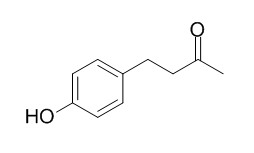4-(4-Hydroxyphenyl)-2-butanone
4-(4-Hydroxyphenyl)-2-butanone(Raspberry ketone,RK) is widely used as a fragrance in cosmetics and as a flavoring agent in foodstuff, it also shows PPAR-α agonistic activity. It is cytotoxic to melanocytes through the binding of RK-derived quinones to thiol proteins and the pro-oxidant activity of the RK-oligomer, the exposure of human skin to RK can cause chemical/occupational leukoderma.
Inquire / Order:
manager@chemfaces.com
Technical Inquiries:
service@chemfaces.com
Tel:
+86-27-84237783
Fax:
+86-27-84254680
Address:
1 Building, No. 83, CheCheng Rd., Wuhan Economic and Technological Development Zone, Wuhan, Hubei 430056, PRC
Providing storage is as stated on the product vial and the vial is kept tightly sealed, the product can be stored for up to
24 months(2-8C).
Wherever possible, you should prepare and use solutions on the same day. However, if you need to make up stock solutions in advance, we recommend that you store the solution as aliquots in tightly sealed vials at -20C. Generally, these will be useable for up to two weeks. Before use, and prior to opening the vial we recommend that you allow your product to equilibrate to room temperature for at least 1 hour.
Need more advice on solubility, usage and handling? Please email to: service@chemfaces.com
The packaging of the product may have turned upside down during transportation, resulting in the natural compounds adhering to the neck or cap of the vial. take the vial out of its packaging and gently shake to let the compounds fall to the bottom of the vial. for liquid products, centrifuge at 200-500 RPM to gather the liquid at the bottom of the vial. try to avoid loss or contamination during handling.
Bulletin of Health Research2016, 44(4):279-286
The Journal of Phytopharmacology2020, 9(1): 1-4
Animals (Basel).2024, 14(20):2990.
Eur J Pharmacol.2021, 906:174220.
Adv Healthc Mater.2024, 13(13):e2303276.
Forensic Sci Int.2022, 341:111475.
J Am Soc Mass Spectrom.2021, 32(5):1205-1214.
Plants (Basel).2021, 10(2):278.
PLoS One.2018, 13(11):e0208055
Environ Toxicol.2021, 36(9):1848-1856.
Related and Featured Products
Chem Res Toxicol. 2017 Mar 20;30(3):859-868.
Tyrosinase-Catalyzed Oxidation of the Leukoderma-Inducing Agent Raspberry Ketone Produces (E)-4-(3-Oxo-1-butenyl)-1,2-benzoquinone: Implications for Melanocyte Toxicity.[Pubmed:
28219012]
The exposure of human skin to 4-(4-Hydroxyphenyl)-2-butanone (raspberry ketone, RK) is known to cause chemical/occupational leukoderma. RK has a structure closely related to 4-(4-hydroxyphenyl)-2-butanol (rhododendrol), a skin whitening agent that was found to cause leukoderma in the skin of consumers in 2013. Rhododendrol is a good substrate for tyrosinase and causes a tyrosinase-dependent cytotoxicity to melanocytes, cells that are responsible for skin pigmentation.
METHODS AND RESULTS:
Therefore, it is expected that RK exerts its cytotoxicity to melanocytes through the tyrosinase-catalyzed oxidation to cytotoxic o-quinones. The results of this study demonstrate that the oxidation of RK by mushroom tyrosinase rapidly produces 4-(3-oxobutyl)-1,2-benzoquinone (RK-quinone), which is converted within 10-20 min to (E)-4-(3-oxo-1-butenyl)-1,2-benzoquinone (DBL-quinone). These quinones were identified as their corresponding catechols after reduction by ascorbic acid. RK-quinone and DBL-quinone quantitatively bind to the small thiol N-acetyl-l-cysteine to form thiol adducts and can also bind to the thiol protein bovine serum albumin through its cysteinyl residue. DBL-quinone is more reactive than RK-quinone, as judged by their half-lives (6.2 min vs 10.5 min, respectively), and decays rapidly to form an oligomeric pigment (RK-oligomer). The RK-oligomer can oxidize GSH to GSSG with a concomitant production of hydrogen peroxide, indicating its pro-oxidant activity, similar to that of the RD-oligomer.
CONCLUSIONS:
These results suggest that RK is cytotoxic to melanocytes through the binding of RK-derived quinones to thiol proteins and the pro-oxidant activity of the RK-oligomer.
Regul Toxicol Pharmacol. 2015 Oct;73(1):196-200.
Raspberry ketone in food supplements--High intake, few toxicity data--A cause for safety concern?[Pubmed:
26160596]
Raspberry ketone (4-(4-Hydroxyphenyl)-2-butanone) is marketed on the Internet as a food supplement. The recommended intake is between 100 and 1400 mg per day. The substance is naturally occurring in raspberries (up to 4.3 mg/kg) and is used as a flavouring substance.
METHODS AND RESULTS:
Toxicological studies on raspberry ketone are limited to acute and subchronic studies in rats. When the lowest recommended daily dose of raspberry ketone (100 mg) as a food supplement is consumed, it is 56 times the established threshold of toxicological concern (TTC) of 1800 μg/day for Class 1 substances. The margin of safety (MOS) based on a NOAEL of 280 mg/kg bw/day for lower weight gain in rats is 165 at 100 mg and 12 at 1400 mg. The recommended doses are a concern taking into account the TTC and MOS.
CONCLUSIONS:
Investigations of raspberry ketone in quantitative structure-activity relationship (QSAR) models indicated potential cardiotoxic effects and potential effects on reproduction/development. Taking into account the high intake via supplements, the compound's toxic potential should be clarified with further experimental studies. In UK the pure compound is regarded as novel food requiring authorisation prior to marketing but raspberry ketone is not withdrawn from Internet sites from this country.



